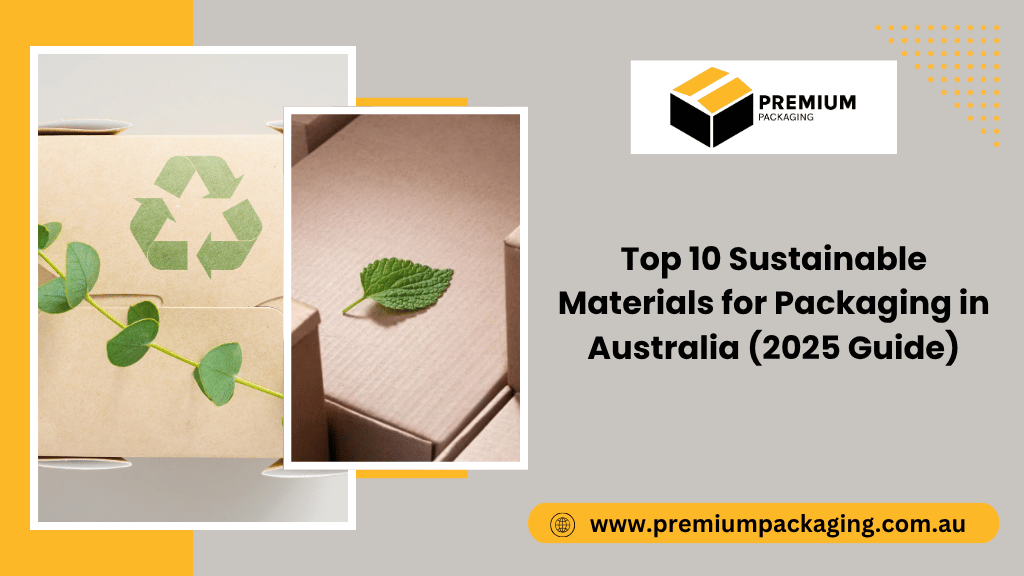As eco-consciousness grows across Australia, businesses are moving beyond plastic and turning to sustainable materials for packaging. Whether you’re a small eCommerce brand or a national distributor, choosing the right materials can lower your carbon footprint and attract eco-savvy customers. If you’re sourcing from a trusted wholesale packaging Australia supplier, it’s important to know what materials to ask for.
In this article, we’ll walk you through the top 10 sustainable packaging materials trending in 2025, backed by the latest industry insights, innovations, and practical business tips.
1. Recycled Kraft Paper
Kraft paper is a classic – durable, recyclable, and biodegradable. It’s ideal for boxes, mailers, and wrapping. Many businesses use it for its rustic, eco-friendly look. According to Noissue, kraft paper can reduce packaging-related emissions by 60%.
Best for:
- Product wraps
- Mailing satchels
- Sleeves and inserts
2. Compostable Mailers (PLA & PBAT)
Compostable mailers made from PLA (Polylactic Acid) and PBAT (Polybutylene Adipate Terephthalate) offer plastic-like performance but break down naturally in home compost bins within 180 days.
3. Corrugated Cardboard
Australia recycles more than 3.5 million tonnes of paper and cardboard every year (ABS, 2023). Corrugated cardboard is not only recyclable but also reusable and strong. It’s perfect for subscription boxes, eCommerce packaging, and heavy goods.
4. Mushroom Packaging
Mushroom packaging is made from mycelium – the root structure of fungi. It grows in moulds around products, offering natural shock absorption. Once discarded, it biodegrades within 30–90 days.
Used by forward-thinking companies like IKEA and Dell, mushroom packaging is gaining traction in Australia too.
5. Cornstarch-Based Packing Peanuts
These dissolve in water, unlike their plastic counterparts. Great for protecting fragile items and reducing landfill waste. Awesome Pack and The Packaging People offer cornstarch filler options for Australian businesses.
6. Recycled Poly Mailers
Not ready to ditch plastic? Recycled poly mailers made from post-consumer waste (PCR) offer a lower-impact alternative. While not compostable, they’re lightweight and often recyclable through soft plastic programs.
Suitable for:
- Fashion brands
- Lightweight eCommerce parcels
7. Glass & Aluminium
Although heavier, glass and aluminium are infinitely recyclable without losing quality. That makes them ideal for premium packaging — from honey jars to skincare containers.
According to Shopify, aluminium cans and bottles have a 68% recycling rate globally — far higher than plastic alternatives.
8. Cellulose & Paper Film
Cellulose-based films offer transparent and moisture-resistant wrapping. Derived from wood pulp, they are compostable and used for wrapping baked goods, produce, and dry foods.
Look for certifications like Home Compostable AS5810 to ensure Aussie compliance.
9. Hemp-Based Packaging
Hemp paper and fibre are rapidly renewable and require less water and pesticide to grow compared to traditional trees. Hemp’s durability and biodegradability make it a rising star in the sustainable packaging space.
Used in:
- Tissue wraps
- Luxury paper bags
- Labels and stationery
10. Mono-Material Packaging
Mono-material packaging uses a single, recyclable material throughout — making it easier to sort and recycle. For example, using only PE (polyethylene) across pouch, seal, and label ensures it qualifies for REDcycle or kerbside collection.
Why It Matters: Consumer Shift & Policy Push
- 72% of Australian consumers prefer products with sustainable packaging (Australian Packaging Covenant Organisation, 2023).
- Australia’s 2025 National Packaging Targets aim for 100% recyclable, compostable, or reusable packaging.
- Failing to adopt eco materials could risk customer loyalty and regulatory compliance.
Where to Start?
When switching to sustainable materials, start with high-volume packaging like satchels or mailer boxes. Work with a trusted wholesale packaging Australia partner that offers both bulk pricing and sustainable alternatives.
Also, consider this eco packaging materials guide to explore recyclable plastic substitutes for everyday products.
FAQs – People Also Ask
- What are the most sustainable materials for packaging?
Kraft paper, mushroom packaging, PLA compostables, and corrugated cardboard are among the most sustainable options for businesses in 2025.
- Why is sustainable packaging important?
It reduces environmental impact, aligns with government regulations, and appeals to eco-conscious consumers.
- Can packaging be both eco-friendly and affordable?
Yes, materials like kraft, recycled poly mailers, and corrugated boxes offer sustainability without breaking the bank.
- Where can I buy eco-friendly packaging in bulk in Australia?
Suppliers like Premium Packaging and The Packaging People offer a wide range of bulk sustainable packaging options.
- Is compostable packaging better than recyclable packaging?
Each has benefits — compostables break down quickly, while recyclables often have longer reuse life. Choose based on your product type and customer base.
